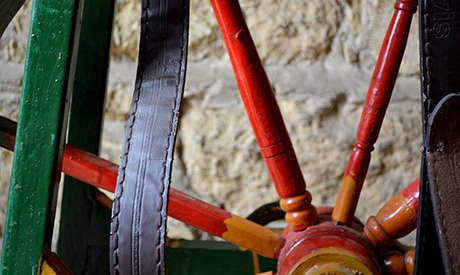Ayman Ramadan
dal 14/2/2015 al 10/3/2015
Segnalato da
14/2/2015
Ayman Ramadan
Townhouse Gallery, Cairo
In 'Mere Real Things', Ayman Ramadan takes on the role of the artist-curator, assembling a selection of utilitarian and decorative household items and rendering them useless by displaying them in an exhibition space.

I think about those objects, those boxes, those utensils that sometimes would turn up in storerooms, kitchens, or hidden spots, and whose use no one can explain anymore. The vanity of believing that we understand the works of time: it buries its dead and keeps the keys. Only in dreams, in poetry, in play — lighting a candle, walking with it along the corridor — do we sometimes arrive at what we were before we were this thing that, who knows, we are. — Julio Cortazar
When does a thing become an art work? And once it becomes an art work, can it ever go back to just being a thing again?
In “Mere Real Things,” Ayman Ramadan takes on the role of the artist-curator, assembling a selection of utilitarian and decorative household items and rendering them useless by displaying them in an exhibition space. Such objects and decorations were once commonplace in middle-class homes and shops across Egypt. But with the advent of the free market and the swift changes in visual culture that globalism ushers in, such items have just as swiftly moved out of their former homes, instead confining themselves to lower-economic households in villages and on the periphery of the city. Given the rapid pace of this trajectory, one can imagine a near future in which these items would divest themselves of their usefulness altogether, and exist only as aesthetic objects of interest in museum displays.
Placing such objects in a white cube context accelerates that transition out of usefulness. In so doing, Ramadan raises questions that trouble the simple assertion that an object is an art object as long as an artist says it is, an assumption that has been more or less accepted since Duchamp decided to put a urinal in a gallery space. If the way of things is to ultimately drift into obsolescence, what happens along that entropic path — do the objects themselves undergo an ontological transformation, or do we as viewers quickly forget how to apprehend them, lose the ability to perceive them correctly once they move into a different relational network? What else do we lose aside from our ability to apprehend these objects — what gestures, social experiences, sounds and conversations were triggered by such things, only to evaporate when the things themselves disappear?
Museums (and by extension contemporary art galleries) have often been described as graveyards — the institutions where objects and ideas become aestheticized to death, frozen in a suspended state of pure perceptual inaction. By hastening the process of their inevitable functional decline and their reemergence as highly valued artifacts, Ramadan elevates these objects to the status of lovely dead things. And by refusing to label them or provide didactic materials explaining their original function, the artist also refuses to let viewers rely on the crutch of historical context to read them. Some viewers may have a vague, lingering memory of what they once were, how they might have touched them — but that nostalgia will inevitably evaporate as these things become ever more entrenched in their new, beautifully inert positions.
Image: courtesy of event's Facebook page
Press Contact:
Sarah Bahgat, sarah@thetownhousegallery.com
Opening: Sunday, February 15, 7 pm
Townhouse Gallery
Hussein El Me'mar Pasha Street
Opening Hours:
Mon - Wed 10am to 9pm
Fri 6pm, Sat
Sun 10am to 9pm



